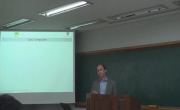We investigate the stable structure and optoelectronic properties of thin γ-GeSe layers through first-principles calculations. We examine three stacking configurations (A-A, A-B, and A-C) of adjacent quadruple layers (QLs), revealing the structural s...
http://chineseinput.net/에서 pinyin(병음)방식으로 중국어를 변환할 수 있습니다.
변환된 중국어를 복사하여 사용하시면 됩니다.
- 中文 을 입력하시려면 zhongwen을 입력하시고 space를누르시면됩니다.
- 北京 을 입력하시려면 beijing을 입력하시고 space를 누르시면 됩니다.
https://www.riss.kr/link?id=A109157161
-
저자
Park Ikpyeong (Incheon National University) ; Kim Jeongwoo (Incheon National University)
- 발행기관
- 학술지명
- 권호사항
-
발행연도
2024
-
작성언어
English
- 주제어
-
등재정보
KCI등재,SCOPUS,SCIE
-
자료형태
학술저널
-
수록면
90-95(6쪽)
- DOI식별코드
- 제공처
-
0
상세조회 -
0
다운로드
부가정보
다국어 초록 (Multilingual Abstract)
We investigate the stable structure and optoelectronic properties of thin γ-GeSe layers through first-principles calculations. We examine three stacking configurations (A-A, A-B, and A-C) of adjacent quadruple layers (QLs), revealing the structural stability of A-C stacking. Due to broken inversion symmetry in atomically thin γ-GeSe layers, shift currents are generated, which are very sensitive to their stacking order and thickness. Despite similar optical absorption trends in A-B and A-C stackings, their shift current responses differ significantly. The shift current is notably decreased at odd-number stackings for all cases, attributed to opposite generated flows between the top and bottom surfaces. The analysis of orbital contributions reveals the charge shift's origin in γ-GeSe. We also explore mechanical modifications, such as sliding and strain, demonstrating the tunability of the shift current spectrum in γ-GeSe. This research enhances our understanding of the optoelectronic response in atomically thin materials, providing valuable insights for future applications.
동일학술지(권/호) 다른 논문
-
Finite temperature properties of rare earth free Fe4CoSi permanent magnet
- 한국물리학회
- Siraj Ul Haq
- 2024
- KCI등재,SCOPUS,SCIE
-
Fabrication perspective of Fe3O4-based cross-cell memristive device for synaptic applications
- 한국물리학회
- Singh Vivek Pratap
- 2024
- KCI등재,SCOPUS,SCIE
-
Progress in TOPCon solar cell technology: Investigating hafnium oxide through simulation
- 한국물리학회
- Rahman Rafi Ur
- 2024
- KCI등재,SCOPUS,SCIE
-
- 한국물리학회
- Mitra Chayan Kumar
- 2024
- KCI등재,SCOPUS,SCIE







 KCI
KCI





